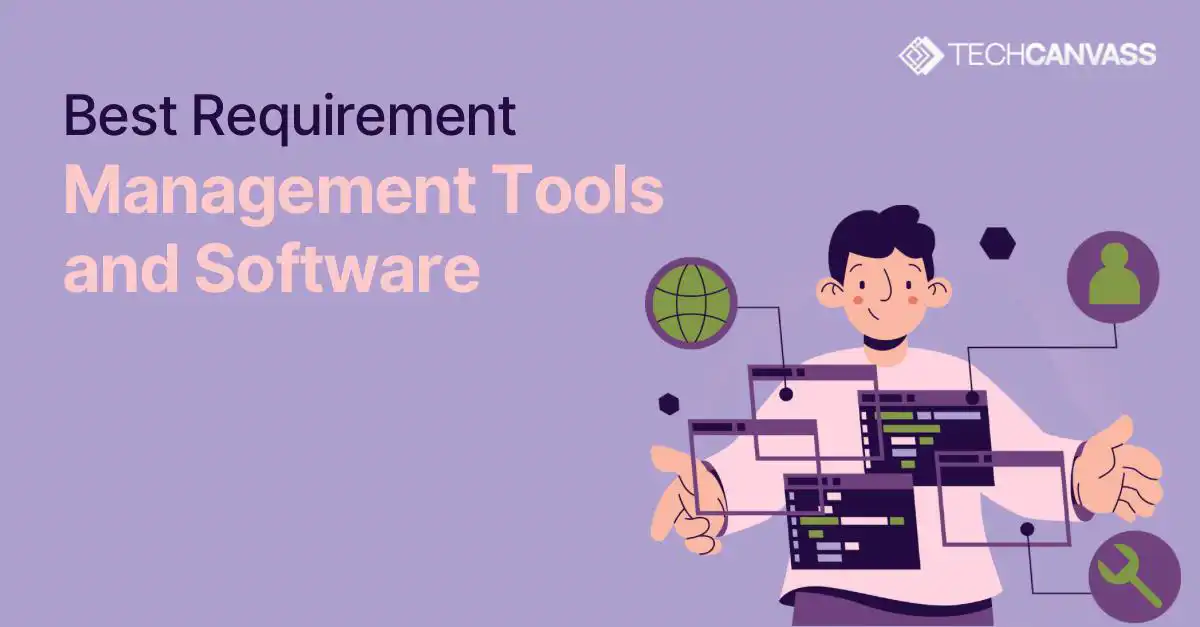Last Updated on October 26, 2024 by Techcanvass Academy
Requirements management is one of the essential job functions for Business Analysts. In a real-world scenario, we deal with multiple situations. For example, if the requirement needs to malfunction, it can lead to poor project management and tarnish business relationships. Sometimes, these requirements tasks fall under a person with limited technical functionality.
If You Can’t Measure It, You Can’t Manage It – Peter Drucker
Requirement Management is an art and science. We have a plethora of tools in the market to manage requirements. As a Business Analyst or Project Manager, you must use a tool to manage the requirements effectively. In this post, we are going to list the top requirement management tools.
What is Requirement Management Software?
We have often seen various project managers handling tasks using some tool or technique. Because they are responsible to maintain the workflow, it is necessary for them to use some outsourcing for it. That is when the role of different requirement management software tools comes into the picture.
The criteria should be in the greatest position possible for the effective delivery of the highest quality product. Similar to this, requirements play a crucial role in the IT sector for successful customer satisfaction and trouble-free delivery of software and applications.
Notifying the stakeholders of any required modifications is another crucial function of requirement management! As long as the Project is active and running, managing requirements is effective.
That is to say, this is a continuous process that lasts the duration of the project. All of the user’s needs are taken into account for the most part and managed in a sensible manner in a requirement management system.
Useful Links – Domain Training Courses
Basic Requirement Tools
Basic requirement tools generally consist of tools that are used for every minute or general project requirements. In that case, you might use an excel sheet or Microsoft PowerPoint. Google Docs, excel sheets, and PowerPoint are a few of the most basic requirement tools that just work totally fine. They might, however, develop into a concern. In this situation, you significantly rely on individuals to update the papers, and it requires time and effort to make sure that all teams are using the most recent version.
Complex Requirement Tools
Your tool may be an entire software system for maintaining the links between requirements, analyzing the impact of any modifications, handling approvals, and more in more intricate requirement management planning.
The most well-known tool on the market is Jira from Atlassian. It has some capabilities for requirements management, like the majority of SW development tools, but Jira requirements management is not a universally applicable solution.
Top 7 Requirement Management Tools In 2022
In 2022, requirement tools are a necessity of every project management system. To manage large projects and keep the value of information properly, requirement tools are used by various project managers, directors, technical team etc. Following is the curated list of requirement tools that will help manage your work effectively.
JIRA
JIRA stands out as a leader in the requirement management tools market. It comes with out-of-the-box customized workflow templates along with built-in roadmaps, customizable dashboards, comprehensive agile reporting, and Strong Software capabilities such as requirement, test case, and task management. Jira supports integration with GitHub, Selenium, etc. General technical skills will suffice to manage cloud solutions. The key aspect of JIRA is that it can manage both Project and Product requirements using existing templates which increases the user base exponentially as compared to other requirement management tools.
Techcanvass offers a course on Jira for Business analysts.
Rational Doors
Rational Doors is IBM’s accredited tool and is present in the market for more than two decades. It is a comprehensive requirement management solution available in both flavors – cloud and on-premise, with strong Software capabilities such as track changes, scalability, test tracking toolkits, customizable workflow, and Centralized requirement management. It supports all types of small, large, and medium enterprises.
The key aspect of Rational Doors is to focus on centralized requirement management and traceability using track changes at all phases of software development processes.
Modern Requirements
Modern Requirements is a popular tool that is a built-in extension to Microsoft’s Azure DevOps. It comes with of box AI-inspired BA assistant, multiple visualization options, and strong Software capabilities such as requirement management, test case automation, and user story generation. In terms of software management set up complexity is low as compared to other tools. It supports all BABOK, BABOK agile, etc.
The key aspect of Modern Requirements is to focus on automation capabilities like BA Assistant, User Story Generation, etc.
Visure
Visure is one of the most trusted requirement management tools in the market. It comes with out-of-box customized compliance templates for ISO26262, IEC62304, IEC61508, etc along with built-in requirement quality using NLP, and strong Software capabilities such as requirement risk management, and bug tracking. It supports integration with JIRA, DOORS, JAMA, WORD, EXCEL, etc. Visual supports all agile methodologies like SCRUM, KANBAN, etc along with waterfall methodology.
SPARX
SPARX is a required tool specifically used to manage Enterprise level requirements. It has Strong Software capabilities such as baseline requirements, generating user documentation, Link requirements to use cases, test cases, architecture building blocks, etc. Manage changes effectively using visual graphs.
The key purpose of SPARX is to focus on enterprise-level requirements and gives the insight to design using UML diagrams.
Spira Team
Like others, Spira Team is also known for it’s authenticity and performance requirements. It is an integrated and QA requirement management tool that manages all your project needs like test cases, releases, defects and issues in the requirement lists on time. You may quickly and simply set up requirements in a hierarchical framework with SpiraTest. Requirements can be estimated, given a priority order, and linked to a particular release. The relevant test coverage for each requirement is shown. Based on a variety of parameters, requirements can be moved, copied, and filtered.
Features Of Requirement Management Tools
If we look at a whole, every requirement management tool has different features according to its use and authenticity. But few of them have the same alignment in terms of work efficiency and feature updates.
Requirement Analysis
Requirements analysis, a key component of requirements management software, relates to useful information such as project scopes and requirement prioritization. Analysis capabilities in requirement management software are advantageous to businesses because they give teams complete visibility into the requirements of each project.
Test Management
Software developers can set up and allocate pertinent software testing using requirements management tools. By using this capability, software engineers can verify that their tests stay inside the intended parameters of the software they’re creating.
Traceability
Because it enables teams to track changes through a continual process of modifying parameters, traceability is essential to effective requirements management. Project teams are unable to record and reference changes as they happen as part of requirements management without traceability.
Why use Requirement Management Software?
Using a requirement management tool can be due for various reasons. A few of the reasons might be to develop and streamline several project tasks, develop goals, or communicate with the team through work.
- Software for requirements management gives interested parties complete access to the project parameters as they change over time.
- The analysis, traceability, and management tools provided by requirements management software enable development teams, stakeholders, and customers to get a thorough grasp of project needs.
- Project teams can keep track of requirement changes thanks to traceability.
- Traceability is essential for keeping requirements management organized because it is a continual activity.
Who uses Requirement Software?
Project teams, stakeholders, and project managers are mostly seen using requirement tools in capacity to bring easy workflow for the team.
- Software for requirements management is the main tool used by project teams to define the specifications of their development projects.
- Software for requirements management records and ranks submitted requirements, providing stakeholders with a tangible method of contributing to projects.
- Businesses occasionally allow customers to submit project requirements using requirements management software.
Conclusion
We have reviewed top requirement management tools all with different capabilities and usage. In choosing one of these, one must consider the below criteria as listed: –
- Integration with Different Software
- Effectiveness in handling the type of software development methodology
- Size of the organization
- Automation and Traceability
- Cost
We offer IT certification courses for professionals. We are an IIBA-endorsed education provider (EEP), iSQI ATP (for Certified Agile Business Analyst Training) as well as an Agile Testing alliance partner for CP-SAT certification training in Selenium. Apart from this, Domain Certification Courses In Banking.



